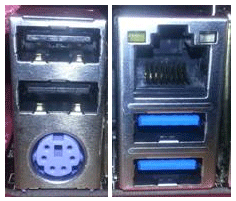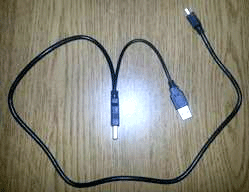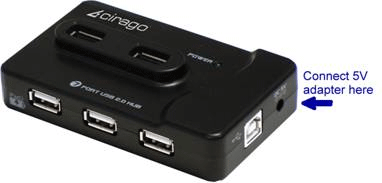USB Power
Description: You've seen the 500GB, 1TB, and even 2TB portable USB devices (hard disk drives and external CD/DVD/BD burners) and may have had some mixed results with getting them to be recognized by your system. Here are some tips to help you save time, frustration, and multiple trips to swap the "bad" unit for another one that works - or fails - in the exact same way.
What makes any computer device turn on and work? Power of course. Power is expressed in two ways: First, voltage or volts (as in +5VDC), which must match the device specs. Using a 19 volt power supply for a 5 volt device will burn out the device. The second is Amperage, either express a number such as 500mA (500/1000 of an Amp) or 4 Amps (a number you more likely see on a laptop charger).
Put them together and you get the real measure of power to drive a device:
Watts = Volts x Amps
But, back to your portable external HDD problem.

Left: USB 2.0 ports (black) and
Right: USB 3.0 ports (blue)

A Y cable with two USB connections for more power to the device.
USB 2.0 ports are supposed to deliver 500mA @ 5 Volts, and USB 2.0 devices are supposed to work with that power. The newer USB 3.0 spec, which acknowledges that new devices need more power, delivers between 900-1000 mA at the same 5 volts.
If you purchased a device with a "Y" cable on it, the single end is connected to your device and both of the two other ends of the "Y" are meant to plug into your computer - one for data and power and the other for power only. Since each port is designed to supply only .5A, by using two ports, your device should be able to draw up to 1A without causing your computer to shut off the USB port. Optical drives and older hard disk drives often require more than the .5A that can be supplied by a single port. Even if the computer does not disable the port an display a warning message, the device may not spin or be detected, and will not work without the second connector plugged in.
Some devices come with a USB cable and the ability to add a 5 Volt power supply to drive them, but this defeats the "portability" of the unit.

And finally for your desktop, there are powered and unpowered USB hubs. Unpowered hubs are usefully for connecting devices that get their power from other sources (a printer that's plugged into the wall, for example), or very low power devices like a USB Flash Drive or USB mouse. Powered Hubs are designed to work with devices that can only be powered through their USB cables.
So, if the device fails at home but works great at Micro Center or on your friend's computer, don't blame the device, it's just looking for more power that your computer is capable of generating.
How do I know this? It happened to me last night, and I work here!
Free technical support is available for your desktops, laptops, printers, software usage and more, via our new community forum, where our tech support staff, or the Micro Center Community will be happy to answer your questions online.
Ask questions and get answers from our technical support team or our community.
PC Builds
Help in Choosing Parts
Troubleshooting

